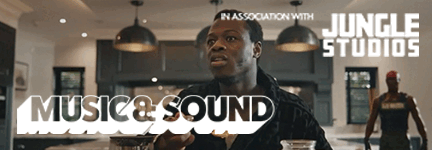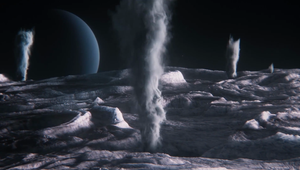
When Music Is at Its Best with Ed de Lacy

Ed de Lacy has twenty years of experience working in sound and now shines bright as one of the most exciting and creative sound designers around. Recent awards include winning Best Sound Design at The British Short Film Awards.
Having spent most of his life channelling a passion for manipulating sound into producing electronic music, Ed prides himself on symbiotically intertwining bespoke music and sound design in his work.
He now passes on his knowledge of sound by leading the annual APA Masterclass course at Little Things every year. Recent work highlights include campaigns and projects for Pepsi, The FA, BBC, Samsung, Burger King, UNIQLO, WeBuyAnyCar and Intel.
Ed sat down with LBB recently to discuss adding his own flavour to his projects, the history of sound and why, in the age of AI, human-crafted sound and music will forever be desired by many…
LBB> When you’re working on a new brief or project, what’s your typical starting point? How do you break it down, and how do you like to generate your ideas or response?
Ed> First thought – what do I want the audience to feel from the sound world I’m creating? Tapping into what the creatives or the director envisaged from the outset is number one for me.
Once I know what feelings they want to convey, I can start to come up with stylistic ideas of how I want the film to sound. This could go in many different directions – fast, languid, comedic, tense, dream-like, slick, smack you in the face, bombastic.
I’ll always start by making anything that’s already been provided to me by the editor as neat and polished as possible. The advancement in technology these days means I can get dialogue and other elements as clean as I want. Once I’m completely happy with any pre-mix, I can add my own flavour.
For a film that needs a huge level of detail (be it real world or more abstracted/interpretive) I typically start by building up every ambient and atmospheric texture to create the right backdrop. Once we have the foundation, the focus moves to the foreground. Spot fx, movement sounds, every last little detail matters. We do whatever it takes to create the right sound. Whether it’s recording foley, using instruments (real and virtual) or reaching into our library - whatever idea I hear in my head will come to fruition.
Not being too literal with spot effects/diegetic sound can be very powerful. For example, using a huge filtered bass-heavy taiko drum to illustrate an object hitting the ground instead of a more literal body fall sound gives a very different and more dramatic feel. Incidentally, this also neatly demonstrates the power of using musical and percussive ideas as a sound designer (something I love to do in the constant search for originality). Not everything has to sound like what you’re seeing.
What I think sets sound designers apart as specialists, and what I take great pride in, is finding that idea that fits in between sounds. It might be something so abstracted that it doesn’t obviously relate to what we’re seeing. A sound that sparks an idea in the viewer’s mind without being literal is really exciting and adds something that only that creative sound designer would add, and makes it theirs alone. These non-diegetic sounds require thought, which is where you put your stamp on it. To actually generate these ideas, I have to force myself to think laterally and avoid anything overly obvious or clichéd.
LBB> Music and sound are in some ways the most collaborative and interactive forms of creativity - what are your thoughts on this? Do you prefer to work solo or with a gang, and what are some of your most memorable professional collaborations?
Ed> Context is so important. In relation to this question, it’s whether I want to be alone to experiment and play before showing some work to a client or if it’s going to be more beneficial to all work together in the studio with a creative team. More often than not, it’s nearly always more fun and inspirational to sit and work with other people. Whether that’s working on sound design, writing music or mixing. Having other people’s ears on my work definitely helps, especially if it’s their baby too.
When it comes to writing music, I’ve always collaborated with friends throughout my life, and it has been nearly always beneficial. You need people around you that you can trust and have an honest relationship with to tell you when something isn’t working. But the music writing/production process is quite different to audio post production. It’s inherently more personal as musical ideas are more ephemeral. For this reason, the composer is probably best left to it, whether they’re working with a writing partner or not. But in post production, sound design lends itself so well to collaboration.
LBB> What’s the most satisfying part of your job and why?
Ed> The single most satisfying part of my job is when clients tell me that they are in love with their project again after our sound sessions together. Being one of the last ports of call in the post production chain, sometimes fatigue will have set in for the creative team. Watching something for the millionth time can do that, I guess. Turning that ennui into enthusiasm and passion again is something I will (selfishly) never get tired of and is one of the biggest compliments a sound designer can get.
LBB> As the advertising industry changes, how do you think the role of music and sound is changing with it?
Ed> I think top-quality music and sound are more important than ever before. With our now well and truly ensconced friend AI taking on more and more of the low-hanging advertising fruit, real human creatives are still going to be sought after to produce the best work. Being at the forefront of this movement, being an expert in using the tools and how things should sound and being able to advise on it, as well as create it, is going to be really important. I believe that truly bespoke, human-crafted sound and music will forever be desired by many.
LBB> Who are your musical or audio heroes and why?
Ed> I’m not a hero worshipper, but in music, there are lots of people I respect greatly. Too many to mention. But a select few absolute dons off the top of my head would be beat makers/producers of various genres - DJ Premier, DJ Shadow, Noisia, Break, Calibre. These artists have each broken ground in their own ways.
I’ve always made electronic music, and my heart lies firmly in my teenage body, being shaped by hip hop and drum and bass. The more I learned about making music, the more I was blown away by artists that left me unable to decipher how they did certain things. This, in turn, helped me develop as I’d then be desperate to find out how they made all those incredible noises. When the most complicated techniques and methods come together to create something so complete and effectively simple, that is when music is at its best for me.
In the world of sound design, I have to give a shout out to one of our industry colleagues, Johnnie Burn at Wave Studios. His work with the director Jonathan Glazer has spanned many years and is a relationship I greatly admire. Having forged a great understanding with each other from their work in the advertising world, they have ended up making some of the most beautiful and moving feature films where sound design is absolutely front and centre and integral to the story.
LBB> And when it comes to your particular field, whether sound design or composing, are there any particular ideas or pioneers that you go back to frequently or who really influence your thinking about the work you do?
Ed> A huge driver for me, and something I come back to regularly, is simply reminding myself of all the points in history where sound and music were advanced in a completely transformative way. The invention of amplification, the first use of stereophonic sound after decades of mono recordings, the introduction of multitrack recording, Ray Dolby and the arrival of surround sound – all these firsts evoke a great sense of humility in me that really spurs me on. I’m in awe of all the many geniuses behind the scenes who have pioneered new technologies. I love being reminded of how small we all are in this world because it’s very grounding and keeps me pushing forward.
I have to admit I adore YouTube for music production techniques and tricks. It’s easy to find videos of your favourite sound designers, artists and producers lifting the lid on their workflow and processes (Tape Notes is particularly great). Making sure you’re always learning from others is super important. It’s worth noting that any musical tricks and techniques are all translatable to sound design because the methods for music creation and sound design are so symbiotic. It’s all the same, really! It’s all sound at the end of the day.
LBB> When you’re working on something that isn’t directly sound design or music (let's say going through client briefs or answering emails), are you the sort of person who needs music and noise in the background, or is that completely distracting to you? What are your thoughts on ‘background’ sound and music as you work?
Ed> It all depends on what I’m doing, really. I think I trick myself into thinking I’m productive when I have music on in the background, but ultimately I just end up going down a rabbit hole. So in reality, when I’m writing anything, silence is golden. If I’m reading through a deck or brief, then I can definitely put something on, as long as it’s instrumental.
LBB> I guess the quality of the listening experience and the context in which audiences listen to music/sound has changed over the years. There’s the switch from analogue to digital, and now we seem to be divided between bad-ass surround-sound immersive experiences and on-the-go, low-quality sound (often the audio is competing with a million other distractions). How does that factor into how you approach your work?
Ed> I wrote a piece on this really recently, actually. I was flying the flag for and championing bass in sound design. In an age where we are consuming content on smaller speakers, it is a good example of something we have lost in certain contexts. So when I’m working, I’m consciously aware of making sure what I produce is going to be effective on whatever device it’s being consumed on. Thinking about the end game is super important. You have to be hyper aware of the difference between working on a huge outdoor experience that is only going to be heard on a massive PA, for example, and mixing something that could end up on TV, a laptop, a smartphone, decent headphones or an expensive sound bar.
LBB> On a typical day, what does your ‘listening diet’ look like?
Ed> Podcast in one ear (quietly) on my bike ride to work. Discovering a bit of new music during the day if I’m doing some admin (see above for distractibility levels). More podcasts at the gym. Another podcast on the way home… and then a bit more podcast while tidying the kitchen and cooking (I’m definitely a victim of being conditioned into nearly always wanting something in my ears).
I also like to spend a bit of time listening to any recent music I’ve made to think about how my mixes sound (often tested in the car much to the chagrin of my young children, who then in turn ultimately make me put on the ‘Dad Kid’s Playlist’ we made together – that mainly consists of Green Day). The car is generally where I’ll listen to music for pleasure, for myself too.
I’m very aware that I spend most of my time at work using my ears in sessions, so occasionally in my own time I will try to force myself to not listen to anything. It’s healthy to rest them, and I think I might be slightly addicted to sound/afraid of silence.
LBB> Do you have a collection of music/sounds, and what shape does it take? Are you a vinyl nerd, do you have hard drives full of random bird sounds, are you a hyper-organised Spotify-er…?
Ed> I’ve got a decent-sized record collection that I treasure and adore, but that sadly doesn’t get used very often because I don’t have space to set up my turntables at home at the moment. It was mainly all purchased in my teens and twenties, and is predominantly hip hop and drum and bass.
I have been making music for so long now that there are numerous hard drives with sounds I’ve made and collected over time from various projects. They develop and morph and travel with you over the years and get recycled and improved constantly – maybe in the vague hope that you will develop a “sound” all of your own one day (god that’s pretentious, eh?).
LBB> Outside of the music and sound world, what sort of art or topics really excite you, and do you ever relate that back to music?
Ed> Like most, I read a bit, I watch the odd film, and very occasionally go to the theatre or an art gallery, but I’d be lying if I said any of these things properly inspire me on a regular basis. I might occasionally watch or read something that sparks an idea, but I think my real passions lie in the sporting world.
I adore football and cycling, and think both have a lot of artistic qualities and influence. The beautiful game and road racing both have aspects that I draw from in my day-to-day life. Both sports’ histories and cultures are aesthetically beautiful. Cycling, in particular, is evocative of a particularly stunning visual identity. The bikes themselves, the jerseys, the scenery, the simultaneous brutality and serenity of bike racing. I feel like on some subconscious level, it all informs my creativity. The sound of wind on a descent, the buzz of a freehub, the roar of a crowd at a football match all touch my mind. I have a clear head when I’m taking part in these sports, and I believe my love of riding bikes (and Arsenal football club) energises me greatly when it comes to my work and new ideas.
LBB> Let’s talk travel! It’s often cited as one of the most creatively inspiring things you can do. I’d love to know about the most exciting or inspiring experiences you’ve had when it comes to sound and music on your travels?
Ed> When I was in my twenties, I toured around India with my friend who at the time was putting on Jungle/Drum and Bass nights all across the country (shout out Bass Foundation – Ed Praxis, Big Daddy Klein and Dehli Sultanate). It was a burgeoning scene in Delhi and Mumbai at the time, and the audiences were so receptive. This underground UK music was all relatively new to India, but something that I had grown up on over here in London. The sights, smells and sounds of India were so in your face that it was very hard not to be inspired. We DJ’d at numerous nights across a couple of weeks, and I came home completely captivated with the place and wanting to make as much new music as possible.
LBB> As we age, our ears change physically and our tastes evolve too, and life changes mean we don’t get to engage in our passions in the same intensity as in our youth. Has your relationship with sound and music changed over the years?
Ed> This is such a great question and one I think about all the time from a few different angles. When I was a child/teenager, I could listen to music and sound for film with complete innocence and be totally absorbed.
In my teens, I discovered buying records and DJing (I wanted to be like DJ Craze or the Scratch Perverts). This drew me into wanting to know more and more about the technology of music production and recording. The more I learned, the more critical and analytical I became of music and the on-screen sound I experienced in daily life.
I would say from my late teens onwards, I had about 15 years of being unable to listen to anything without breaking it down into its constituent parts in my mind. It was incredibly interesting and stimulating to me, but I didn’t enjoy music in the truly carefree way most people do.
Slowly over the years, I trained my brain to stop analysing as much and just enjoy what I was hearing for what it was, a piece of art to be experienced. I find this whole process fascinating, and the fact that I was conscious of it and able to make a change over time boggles my mind slightly.
The other aspect is indeed that, as I’ve gotten older, as many people will relate to, my life has gotten smaller. My youth was spent going out, playing in clubs, making music with friends, partying and staying up late.
Now with a family and career, life is very different. I wouldn’t change it for the world, but it’s definitely less wild. So what goes into my ears when is noticeably different too. I take immeasurable joy from my work because it is during these weekdays that I get to play with music and sound and do what was once just a hobby growing up.












